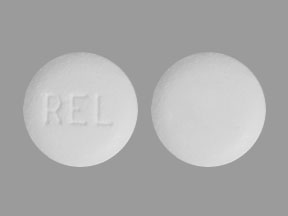Methylnaltrexone Dosage
Medically reviewed by Drugs.com. Last updated on Jan 24, 2024.
Applies to the following strengths: 12 mg/0.6 mL; 150 mg; 8 mg/0.4 mL
Usual Adult Dose for:
Additional dosage information:
Usual Adult Dose for Constipation - Drug Induced
Opioid-Induced Constipation in Patients with Chronic Non-Cancer Pain:
- Oral: 450 mg orally once a day in the morning
- Parenteral: 12 mg subcutaneously once a day
Comments:
- Prior to initiation, discontinue all maintenance laxative therapy; laxatives can be used as needed for suboptimal response after 3 days.
- Patients should be within close proximity to a bathroom once this drug is administered.
- Re-evaluate continued need for this drug when the opioid regimen is changed to avoid adverse reactions.
Opioid-Induced Constipation in Patients with Advanced Illness:
Parenteral: Weight-based dosing: Administer subcutaneously every other day as needed, but no more frequently than 1 dose in a 24-hour period:
Less than 38 kg: 0.15 mg/kg
38 kg to less than 62 kg: 8 mg (0.4 mL)
62 kg to 114 kg: 12 mg subcutaneously (0.6 mL)
More than 114 kg: 0.15 mg/kg subcutaneously
Comments: To determine injection volume for patients whose weight is less than 38 kg or more than 114 kg: multiply patient weight (kg) by 0.0075 and round up to the nearest 0.1 mL
Uses:
- For the treatment of opioid-induced constipation in adult patients with chronic non-cancer pain or advanced illness who are receiving palliative care, when the response to laxative therapy has not been sufficient.
Renal Dose Adjustments
Moderate to severe renal impairment (CrCl less than 60 mL/min):
Chronic Non-Cancer Pain:
- Oral: 150 mg orally once a day in the morning
- Parenteral: 6 mg subcutaneously once a day
Advanced Illness:
Parenteral: weight-based dosing:
Less than 38 kg: 0.075 mg/kg subcutaneously every other day
38 to less than 62 kg: 4 mg subcutaneously every other day
62 to 114 kg: 6 mg subcutaneously every other day
Greater than 114 kg: 0.075 mg/kg subcutaneously every other day
Comments: To determine injection volume for patients whose weight is less than 38 kg or more than 114 kg: multiply patient weight (kg) by 0.0075 and round up to the nearest 0.1 mL
Liver Dose Adjustments
Moderate to severe hepatic impairment (Child-Pugh Class B or C):
- Chronic Non-Cancer Pain: Oral: 150 mg orally once a day in the morning
Severe hepatic impairment: Chronic Non-Cancer Pain or Advanced illness:
- Parenteral: Weight-based dosing:
38 to less than 62 kg: 4 mg subcutaneously every other day
62 to 114 kg: 6 mg subcutaneously every other day
Greater than 114 kg: 0.075 mg/kg subcutaneously every other day
Comments: To determine injection volume for patients whose weight is less than 38 kg or more than 114 kg: multiply patient weight (kg) by 0.0075 and round up to the nearest 0.1 mL
Precautions
Safety and efficacy have not been established in patients younger than 18 years.
Consult WARNINGS section for additional precautions.
Dialysis
Data not available
Other Comments
Administration advice:
- Once administered, important to be within close proximity to toilet facilities
Oral tablets:
- Take with water on an empty stomach at least 30 minutes before the first meal of the day
Parenteral:
- For subcutaneous injection only; do not administer more than 1 dose in a 24-hour period
- Rotation of injection sites is recommended; suggested injection sites are upper legs, abdomen and upper arms
Storage requirements:
- Store at room temperature, do not freeze
- If drug has been drawn into a syringe, stable at room temperature for up to 24 hours
- Protect from light
Reconstitution/preparation techniques: See product information.
General:
- If treatment with opioid pain medication is discontinued, this drug should be discontinued; if opioid regimen is change, re-evaluate continued need of this drug.
- In clinical trials in patients with advanced illness, this drug was administered concomitantly with a laxative regimen.
- In patients with chronic non-cancer pain, all maintenance laxative therapy should be discontinued prior to initiating therapy; laxatives can be used as needed after 3 days.
- This drug has been shown to be efficacious in patients who have taken opioids for at least 4 weeks; sustained exposure to opioids prior to starting this drug may increase the patient's sensitivity to this drug.
Monitoring:
- Monitor for the development of severe, persistent, or worsening abdominal pain; discontinue therapy if this occurs.
Patient advice:
- Patients should be instructed to be within close proximity to toilet facilities once this drug is taken.
- Patients should be instructed to seek medical attention promptly if unusually severe, persistent, or worsening abdominal pain or diarrhea develops.
- Patients should understand that symptoms of opioid withdrawal such as sweating, chills, anxiety, irritability, and yawning may occur.
- Patients should speak to health care professional if they become pregnant, intend to become pregnant, or are breastfeeding.
Frequently asked questions
More about methylnaltrexone
- Check interactions
- Compare alternatives
- Reviews (63)
- Side effects
- During pregnancy
- Drug class: peripheral opioid receptor antagonists
- Breastfeeding
- En español
Patient resources
- Methylnaltrexone oral/injection drug information
- Methylnaltrexone (Advanced Reading)
- Methylnaltrexone bromide (Advanced Reading)
- Methylnaltrexone Tablets
Other brands
Professional resources
Other brands
Related treatment guides
Further information
Always consult your healthcare provider to ensure the information displayed on this page applies to your personal circumstances.


